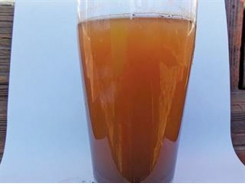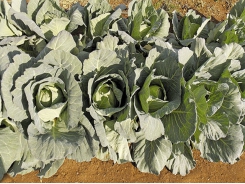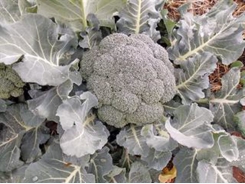Know your soil – Part 5: the value of phosphorous

Continuing with our discussion of the soil analysis, we now come to phosphorous (P).
The cabbages in the foreground are a lighter colour with a pink blush. This is not a phosphorus deficiency but a nitrogen deficiency. The darker plants behind have no pink colouration.
South Africa’s soils, unless they are fertilised, are generally deficient in this element, which usually measures no more than a few parts per million (ppm). Personally, I would avoid planting vegetables in soil where the content is below 20ppm, but we can get away with less for some crops.
Many fertiliser reps grow anxious when the soil analysis shows a high P reading and will caution you that you are heading for trouble as too much P will render other elements unavailable to the crop. There is an upper limit for any element, but I have seen readings of up to 500ppm of P with no negative results to the crop.
However, I do know that some farmers pick up problems with higher readings because they regularly use large quantities of poultry manure from layer farms.
Phosphorus is a highly reactive element with a negative charge and readily binds with other elements such as aluminium (Al), calcium (Ca), iron, manganese and others. For this reason, it does not move far in the soil even when in a soluble form. When the soil pH is below 5,5, P binds readily with Al, making it almost unavailable to plants. P is most available at a pH of 7 to 7,2, when it can bind readily with calcium in a form where the bond is more easily broken.
If the pH is low due to circumstances or intent (as with potato and scab), band-place the mixture to reduce exposure to elements that make P unavailable to the plant.
Superphosphate is a soluble form of P made by combining finely ground rock phosphate with acid. It will move very slightly in the soil until it is bound. Finely ground rock phosphate is sometimes used in acidic soils because the acidity can make some of the P available. South Africa’s source of rock phosphate is very hard and its use for this purpose is questionable. The rock phosphate mined in Langebaan in the Cape makes an excellent fertiliser but due to high transport costs, it is unfortunately too expensive for farmers in the hinterland.
Stunted growth
A client of mine once established a farm and planted potatoes, bandplacing the fertiliser mixture in the ridge as is the usual practice. He followed this crop with carrots and did not fertilise because in soil where vegetables are regularly planted, the carrots scavenge the leftover fertiliser.
The carrot beds were laid at an angle to the potato rows. By the time the carrots were at the four-leaf stage, the crop was stunted with a lighter colour and purpling. However, there were healthy strips corresponding with the previous potato rows.
As the overall deficiency was due to a lack of P, the farmer could not incorporate the element without destroying the crop. Instead, we applied a healthy application of superphosphate on the surface. Shortly afterwards, the crop recovered. The lines demarcating the previous potato rows were no longer visible and a good yield was harvested.
Phosphorus vs nitrogen
In most crops, some purpling of the leaves is the general sign of a P deficiency. Farmers often tell me they have a P deficiency in their brassica crops when the plants are a lighter colour and develop a pink blush. But this is actually nitrogen (N) deficiency.
You can be doubly sure there is a P deficiency if the leaves retain the purple tinge after being well fertilised with N.
Although humus does not on its own contribute much P to the plant, it provides available P by supporting more soil microbes. These unlock P from the soil particles and release available P fixed by combining with other minerals. Earthworms also contribute to this process. The fact that P is less available when soil is cold probably has much to do with the inactivity of microbes at lower temperatures.
Tools

Phối trộn thức ăn chăn nuôi

Pha dung dịch thủy canh

Định mức cho tôm ăn

Phối trộn phân bón NPK

Xác định tỷ lệ tôm sống

Chuyển đổi đơn vị phân bón

Xác định công suất sục khí

Chuyển đổi đơn vị tôm

Tính diện tích nhà kính

Tính thể tích ao




 Slow US planting, growing seasons end in delayed…
Slow US planting, growing seasons end in delayed…  Know your soil – Part 4
Know your soil – Part 4